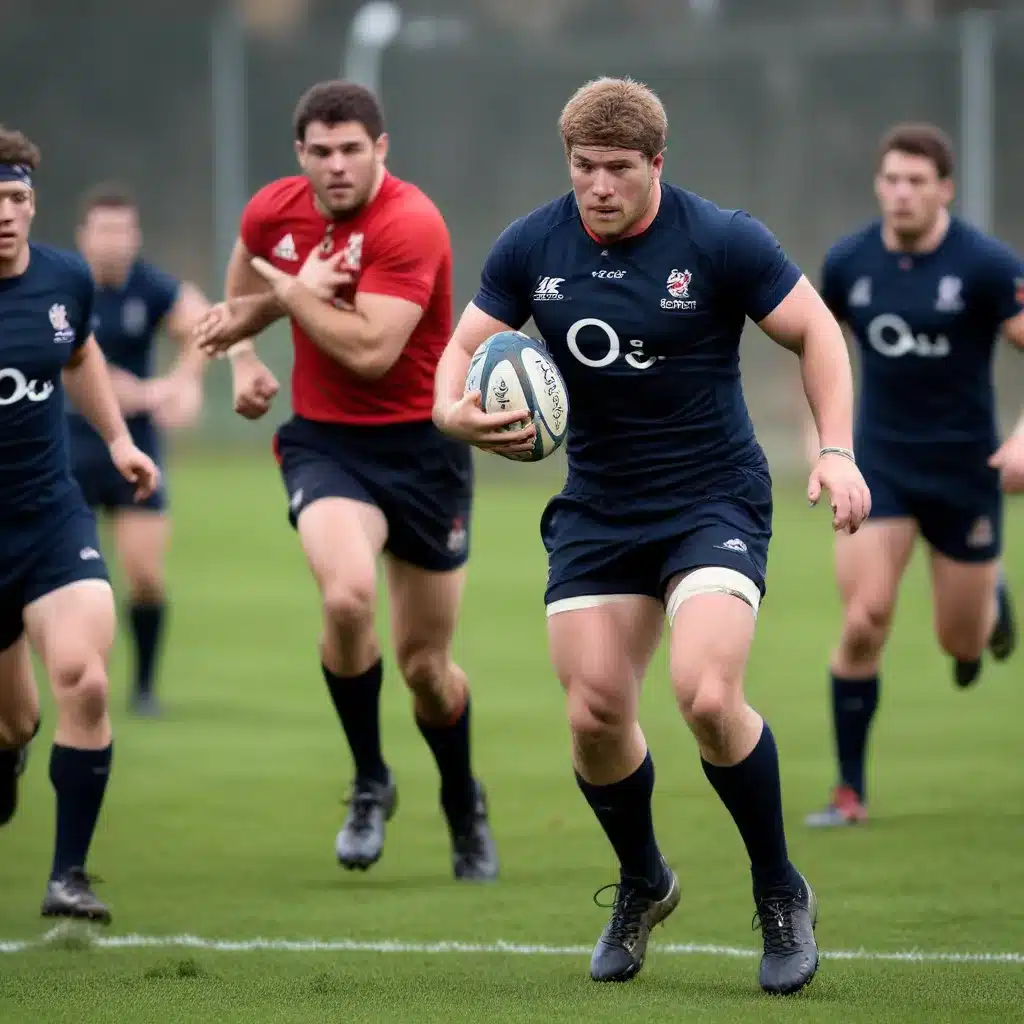
Rugby Footwork Fundamentals
As a seasoned rugby professional, I know that footwork and change of direction are critical skills for dominating matches. Proper foot placement, weight distribution, and overall balance and body control form the foundation for agile movements on the pitch.
When it comes to foot placement, rugby players must be mindful of keeping their feet shoulder-width apart, with toes pointed slightly outward. This base of support allows for quick shifts in direction and stable body positioning when engaged in contact. Weight should be evenly distributed across the midfoot, ready to spring into action at a moment’s notice. Maintaining a low center of gravity, with knees bent and hips shifted back, is key for remaining balanced and poised to change direction.
Agility and Change of Direction
The ability to change directions at speed is a game-changer in rugby. Cutting movements, lateral quickness, and overall agility allow players to evade defenders, create space, and gain valuable meters. Whether it’s a sidestepping flyhalf or a powerful ball-carrying forward, these skills are essential for match dominance.
Developing agility requires a combination of physical conditioning, technical training, and game-like scenarios. Players must train their bodies to react quickly to visual cues, anticipate defensive movements, and seamlessly transition between linear sprints, lateral shuffles, and explosive cuts. Drill progressions that challenge players’ decision-making and coordination are invaluable for honing these abilities.
Drills for Improving Rugby Footwork
Ladder Drills
Ladder drills are a staple for enhancing footwork and coordination in rugby. By navigating through a series of rungs, players must focus on precise foot placement, rhythm, and speed. Start with basic forward and backward patterns, gradually increasing complexity with side-to-side, zig-zag, and other multidirectional movements. Encourage players to maintain a low, athletic stance and drive through each drill with intent.
Cone Drills
Cone drills offer a dynamic environment for practicing change of direction. Set up a series of cones in various patterns, such as zig-zags, figure-eights, and lateral shuffles. Challenge players to navigate the course with control, making sharp, explosive cuts to navigate the obstacles. Emphasize proper body positioning, weight transfer, and the ability to accelerate out of each change of direction.
Reaction Drills
Incorporating reaction-based drills is crucial for developing the split-second decision-making and anticipation skills required in rugby. Use visual or auditory cues to prompt players to react and change direction accordingly. This could involve using a coach’s command, a flashing light, or a moving target to elicit a rapid response. By training their bodies to react instinctively, players will be better equipped to navigate the chaos of a rugby match.
Enhancing Rugby Match Dominance
Effective footwork and change of direction are essential, but they must be complemented by a holistic approach to performance enhancement. Physical conditioning, tactical awareness, and mental preparation all play integral roles in a player’s ability to dominate on the pitch.
Physical Conditioning
Developing a foundation of strength, power, and endurance will provide the physical capabilities necessary for explosive movements and sustained match-day performance. Incorporating compound exercises, plyometrics, and high-intensity interval training into your training regimen can help build the requisite physical attributes.
Tactical Awareness
Game sense, decision-making, and adaptability are crucial for translating technical skills into match dominance. Expose players to game-like scenarios, challenging them to read defensive cues, anticipate opposition movements, and make split-second tactical decisions. By fostering a deep understanding of the game, players will be better equipped to utilize their footwork and change of direction to maximum effect.
Mental Preparation
Confidence, focus, and composure are vital mental skills for dominating on the rugby pitch. Implement visualization exercises, mindfulness techniques, and pressure-based training to help players develop the mental resilience necessary to perform at their best, even in the most challenging match situations.
Optimizing Rugby Training for Performance
Integrating footwork and change of direction drills into a comprehensive training program is essential for maximizing performance on match day. By carefully progressivprogressionning the complexity and specificity of the drills, players can develop a robust skillset that translates seamlessly to the game.
Integrating Footwork and Change of Direction
Begin with foundational footwork patterns and gradually introduce more game-specific movements. Ladder drills, cone drills, and reaction-based exercises should start in a controlled environment and progress to incorporate greater speed, decision-making, and competitive elements. Regularly monitor player proficiency and adjust the drill selection accordingly.
Periodization and Periodicity
Adopt a periodized approach to training, allocating specific phases for developing physical capacities, technical skills, and tactical awareness. Within this framework, incorporate regular opportunities for players to practice footwork and change of direction in a variety of contexts, from isolated drills to full-team training sessions and even match simulations.
Individualized Approach
Recognizing that each player has unique physical attributes, skill sets, and learning styles, it’s essential to adopt an individualized approach to training. Conduct comprehensive player profiling to identify each individual’s strengths, weaknesses, and areas for improvement. Tailor the drills and exercises to address their specific needs, ensuring optimal development and transfer to match performance.
By consistently emphasizing the importance of footwork and change of direction, embracing a holistic approach to performance enhancement, and implementing a structured, individualized training program, rugby players can unlock their full potential and dominate on the pitch. As the coach of the Aberdeenshire RFC, I’m committed to guiding my players towards this level of match dominance, one drill and one game at a time.
